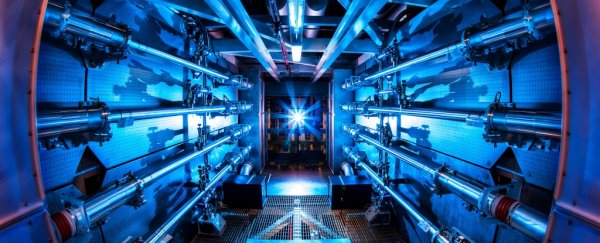
A major milestone has been breached in the quest for fusion energy.
For the first time, a fusion reaction has achieved a record 1.3 megajoule energy output – and for the first time, exceeding energy absorbed by the fuel used to trigger it.
Although there's still some way to go, the result represents a significant improvement on previous yields: eight times greater than experiments conducted just a few months prior, and 25 times greater than experiments conducted in 2018. It's a huge achievement.
Physicists at the National Ignition Facility at the Lawrence Livermore National Laboratory will be submitting a paper for peer review.
"This result is a historic step forward for inertial confinement fusion research, opening a fundamentally new regime for exploration and the advancement of our critical national security missions. It is also a testament to the innovation, ingenuity, commitment and grit of this team and the many researchers in this field over the decades who have steadfastly pursued this goal," said Kim Budil, director of the Lawrence Livermore National Laboratory.
"For me, it demonstrates one of the most important roles of the national labs – our relentless commitment to tackling the biggest and most important scientific grand challenges and finding solutions where others might be dissuaded by the obstacles."
Inertial confinement fusion involves creating something like a tiny star. It starts with a capsule of fuel, consisting of deuterium and tritium – heavier isotopes of hydrogen. This fuel capsule is placed in a hollow gold chamber about the size of a pencil eraser called a hohlraum.
Then, 192 high-powered laser beams are blasted at the hohlraum, where they are converted into X-rays. These X-rays implode the fuel capsule, heating and compressing it to conditions comparable to those in the center of a star – temperatures in excess of 100 million degrees Celsius (180 million Fahrenheit) and pressures greater than 100 billion Earth atmospheres – turning the fuel capsule into a tiny blob of plasma.
And, just as hydrogen fuses into heavier elements in the heart of a main-sequence star, so too does the deuterium and tritium in the fuel capsule. The whole process takes place in just a few billionths of a second. The goal is to achieve ignition – a point at which the energy generated by the fusion process exceeds the total energy input.
The experiment, conducted on 8 August, fell just short of that mark; the input from the lasers was 1.9 megajoules. But it's still tremendously exciting, because according to the team's measurements, the fuel capsule absorbed over five times less energy than it generated in the fusion process.
This, the team said, is the result of painstaking work refining the experiment, including the design of the hohlraum and capsule, improved laser precision, new diagnostic tools, and design changes to increase the speed of the implosion of the capsule, which transfers more energy to the plasma hotspot in which fusion takes place.
"Gaining experimental access to thermonuclear burn in the laboratory is the culmination of decades of scientific and technological work stretching across nearly 50 years," said Thomas Mason, director of the Los Alamos National Laboratory.
"This enables experiments that will check theory and simulation in the high energy density regime more rigorously than ever possible before and will enable fundamental achievements in applied science and engineering."
The team plans to conduct follow-up experiments to see if they can replicate their result, and to study the process in greater detail. The result also opens up new avenues for experimental research.
The physicists also hope to work out how to further increase energy efficiency. A lot of energy is lost when the laser light is converted into X-rays inside the hohlraum; a large proportion of the laser light instead goes into heating the hohlraum walls. Solving this problem will take us another significant step closer to fusion energy.
In the meantime, though, the researchers are tremendously excited.
"Achieving ignition in a laboratory remains one of the scientific grand challenges of this era and this result is a momentous step forward towards achieving that goal," said physicist Johan Frenje of MIT's Plasma Science and Fusion Center.
"It also enables the exploration of a fundamentally new regime that is extremely difficult to access experimentally, furthering our understanding of the processes of fusion ignition and burn, which is critical for validating and enhancing our simulation tools in support of the stockpile stewardship.
"In addition, the result is historic as it represents the culmination of many decades of hard work, innovation and ingenuity, team work on a large scale, and relentless focus on the ultimate goal."
The team presented their results at the 63rd Annual Meeting of the APS Division of Plasma Physics.
